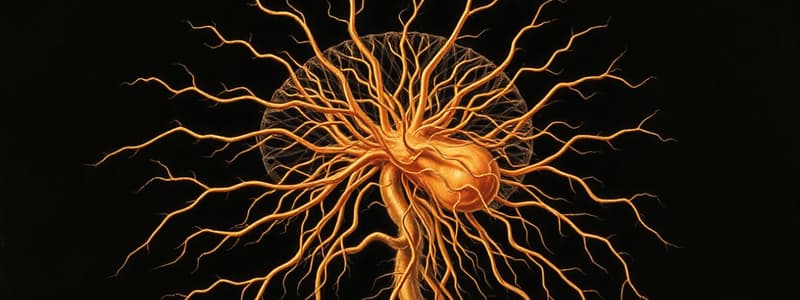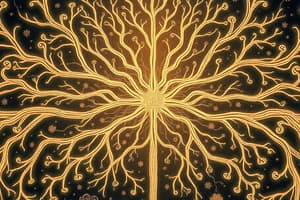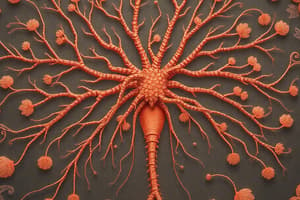Podcast
Questions and Answers
Which division of the Peripheral Nervous System is primarily responsible for voluntary movements?
Which division of the Peripheral Nervous System is primarily responsible for voluntary movements?
What type of receptors monitor smell and taste within the sensory component of the PNS?
What type of receptors monitor smell and taste within the sensory component of the PNS?
Which effectors are influenced by the sympathetic division of the autonomic nervous system?
Which effectors are influenced by the sympathetic division of the autonomic nervous system?
What is the role of afferent division in the Peripheral Nervous System?
What is the role of afferent division in the Peripheral Nervous System?
Signup and view all the answers
Which aspect of the autonomic nervous system typically promotes rest and digestion?
Which aspect of the autonomic nervous system typically promotes rest and digestion?
Signup and view all the answers
Somatic sensory receptors are responsible for monitoring which of the following?
Somatic sensory receptors are responsible for monitoring which of the following?
Signup and view all the answers
Which division of the PNS is responsible for involuntary control over cardiac muscle?
Which division of the PNS is responsible for involuntary control over cardiac muscle?
Signup and view all the answers
What are the primary components of the central nervous system?
What are the primary components of the central nervous system?
Signup and view all the answers
Which division of the peripheral nervous system is responsible for carrying sensory information?
Which division of the peripheral nervous system is responsible for carrying sensory information?
Signup and view all the answers
What type of muscle is primarily controlled by the parasympathetic division?
What type of muscle is primarily controlled by the parasympathetic division?
Signup and view all the answers
Efferent signals from the CNS primarily target which type of recipients in the PNS?
Efferent signals from the CNS primarily target which type of recipients in the PNS?
Signup and view all the answers
What type of tissue is primarily found in the central nervous system?
What type of tissue is primarily found in the central nervous system?
Signup and view all the answers
Which of the following structures connects to the brain as part of the peripheral nervous system?
Which of the following structures connects to the brain as part of the peripheral nervous system?
Signup and view all the answers
Which of the following correctly describes the role of visceral sensory receptors?
Which of the following correctly describes the role of visceral sensory receptors?
Signup and view all the answers
What role do effectors play in the nervous system?
What role do effectors play in the nervous system?
Signup and view all the answers
How do the peripheral nerves primarily function within the nervous system?
How do the peripheral nerves primarily function within the nervous system?
Signup and view all the answers
What is the primary function of the central nervous system?
What is the primary function of the central nervous system?
Signup and view all the answers
Which of the following best describes the composition of peripheral nerves?
Which of the following best describes the composition of peripheral nerves?
Signup and view all the answers
Which receptor type is NOT included in the peripheral nervous system's functional divisions?
Which receptor type is NOT included in the peripheral nervous system's functional divisions?
Signup and view all the answers
What aspect of the brain is associated with higher functions such as intelligence and memory?
What aspect of the brain is associated with higher functions such as intelligence and memory?
Signup and view all the answers
What is the primary function of the somatic nervous system (SNS)?
What is the primary function of the somatic nervous system (SNS)?
Signup and view all the answers
Which division of the peripheral nervous system is responsible for subconscious actions?
Which division of the peripheral nervous system is responsible for subconscious actions?
Signup and view all the answers
What distinguishes the sympathetic division from the parasympathetic division of the autonomic nervous system?
What distinguishes the sympathetic division from the parasympathetic division of the autonomic nervous system?
Signup and view all the answers
How many neurons are estimated to be in the enteric nervous system (ENS)?
How many neurons are estimated to be in the enteric nervous system (ENS)?
Signup and view all the answers
Which of the following actions is primarily controlled by the autonomic nervous system?
Which of the following actions is primarily controlled by the autonomic nervous system?
Signup and view all the answers
What role does the enteric nervous system (ENS) play in the body?
What role does the enteric nervous system (ENS) play in the body?
Signup and view all the answers
What type of muscle contractions does the autonomic nervous system (ANS) NOT control?
What type of muscle contractions does the autonomic nervous system (ANS) NOT control?
Signup and view all the answers
What is one of the primary neurotransmitters used by the enteric nervous system (ENS)?
What is one of the primary neurotransmitters used by the enteric nervous system (ENS)?
Signup and view all the answers
Which component of the nervous system processes and coordinates sensory input and motor commands?
Which component of the nervous system processes and coordinates sensory input and motor commands?
Signup and view all the answers
Which division of the peripheral nervous system is mainly associated with reflex responses?
Which division of the peripheral nervous system is mainly associated with reflex responses?
Signup and view all the answers
Which type of receptors are responsible for monitoring internal organs within the Peripheral Nervous System?
Which type of receptors are responsible for monitoring internal organs within the Peripheral Nervous System?
Signup and view all the answers
Which division of the autonomic nervous system is primarily associated with the 'fight or flight' response?
Which division of the autonomic nervous system is primarily associated with the 'fight or flight' response?
Signup and view all the answers
Which type of muscle is influenced by the somatic nervous system?
Which type of muscle is influenced by the somatic nervous system?
Signup and view all the answers
Which component of the afferent division is primarily responsible for monitoring skeletal muscles?
Which component of the afferent division is primarily responsible for monitoring skeletal muscles?
Signup and view all the answers
In the context of the PNS, what role do effectors serve?
In the context of the PNS, what role do effectors serve?
Signup and view all the answers
What is the primary responsibility of the central nervous system?
What is the primary responsibility of the central nervous system?
Signup and view all the answers
Which of the following best defines the function of the afferent division of the peripheral nervous system?
Which of the following best defines the function of the afferent division of the peripheral nervous system?
Signup and view all the answers
What is the primary characteristic of the somatic nervous system (SNS)?
What is the primary characteristic of the somatic nervous system (SNS)?
Signup and view all the answers
Which structure is NOT considered part of the central nervous system?
Which structure is NOT considered part of the central nervous system?
Signup and view all the answers
What distinguishes the sympathetic division of the autonomic nervous system from the parasympathetic division?
What distinguishes the sympathetic division of the autonomic nervous system from the parasympathetic division?
Signup and view all the answers
What type of tissue primarily constitutes the peripheral nervous system?
What type of tissue primarily constitutes the peripheral nervous system?
Signup and view all the answers
Which of the following is NOT a primary function of effectors in the nervous system?
Which of the following is NOT a primary function of effectors in the nervous system?
Signup and view all the answers
Which function is primarily coordinated by the enteric nervous system (ENS)?
Which function is primarily coordinated by the enteric nervous system (ENS)?
Signup and view all the answers
What type of cells may serve as receptors in the peripheral nervous system?
What type of cells may serve as receptors in the peripheral nervous system?
Signup and view all the answers
How does the autonomic nervous system (ANS) influence muscle types?
How does the autonomic nervous system (ANS) influence muscle types?
Signup and view all the answers
Which of the following statements about peripheral nerves is accurate?
Which of the following statements about peripheral nerves is accurate?
Signup and view all the answers
What is a primary role of the autonomic nervous system (ANS)?
What is a primary role of the autonomic nervous system (ANS)?
Signup and view all the answers
Which neurotransmitters are utilized by the enteric nervous system (ENS)?
Which neurotransmitters are utilized by the enteric nervous system (ENS)?
Signup and view all the answers
Which division of the nervous system integrates, processes, and coordinates sensory input?
Which division of the nervous system integrates, processes, and coordinates sensory input?
Signup and view all the answers
Which muscle types does the enteric nervous system (ENS) have a direct effect on?
Which muscle types does the enteric nervous system (ENS) have a direct effect on?
Signup and view all the answers
What is a notable feature of the efferent division of the peripheral nervous system (PNS)?
What is a notable feature of the efferent division of the peripheral nervous system (PNS)?
Signup and view all the answers
Which statement is true regarding the autonomic nervous system (ANS) divisions?
Which statement is true regarding the autonomic nervous system (ANS) divisions?
Signup and view all the answers
Study Notes
Anatomical Divisions of the Nervous System
- The nervous system has two main anatomical divisions: central and peripheral.
Central Nervous System (CNS)
- The CNS includes the brain and spinal cord.
- It's composed of nervous tissue, connective tissue, and blood vessels.
- It processes and coordinates sensory data from inside and outside the body.
- It controls activities of peripheral organs, such as skeletal muscles.
- Higher brain functions include intelligence, memory, learning, and emotion.
Peripheral Nervous System (PNS)
- The PNS includes all nervous tissue outside the central nervous system (CNS) and enteric nervous system (ENS).
- It delivers sensory information to the CNS.
- It carries motor commands to peripheral tissues.
- Nerves are bundles of axons with connective tissues and blood vessels.
- Nerves carry sensory information and motor commands.
- Cranial nerves connect to the brain.
- Spinal nerves attach to the spinal cord.
Functional Divisions of the PNS
- Afferent division: Carries sensory information from receptors in peripheral tissues and organs to the CNS.
- Efferent division: Carries motor commands from the CNS to muscles, glands, and adipose tissue.
Receptors
- Detect changes or respond to stimuli.
- May be neurons or specialized cells.
- May be single cells or complex sensory organs (like eyes and ears).
Effectors
- Target organs that respond to motor commands.
Efferent Division of PNS
- Somatic Nervous System (SNS): Controls skeletal muscle contractions (both voluntary and involuntary reflexes).
- Autonomic Nervous System (ANS): Controls subconscious actions, contractions of smooth and cardiac muscle, and glandular secretions.
- The ANS has two subdivisions: sympathetic (stimulating) and parasympathetic (relaxing).
Enteric Nervous System (ENS)
- Contains 100 million neurons in the walls of the digestive tract (as many or more than in the spinal cord).
- Uses the same neurotransmitters as the brain.
- Initiates and coordinates visceral reflexes locally without instructions from the CNS.
- Can be influenced by the ANS.
Studying That Suits You
Use AI to generate personalized quizzes and flashcards to suit your learning preferences.
Related Documents
Description
Explore the anatomy of the nervous system with this quiz, focusing on the central and peripheral divisions. Learn about the functions and components of the CNS, including the brain and spinal cord, as well as the role of the PNS in relaying information. Test your knowledge on this critical aspect of human biology.




